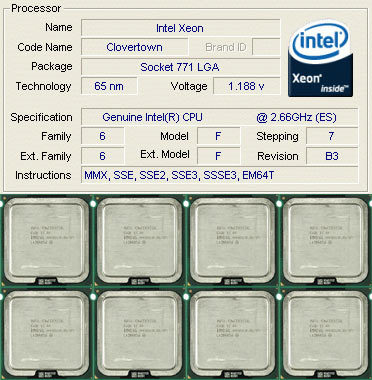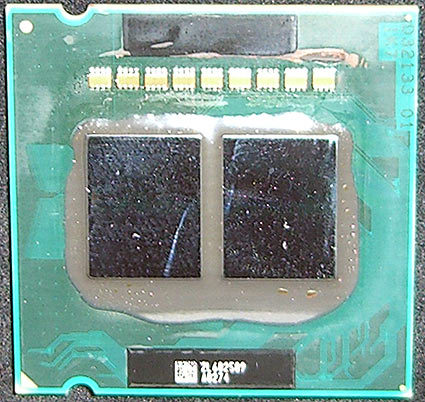Quad-Core Xeon Clovertown Rolls Into DP Servers
Clovertown Moves Quad-Core CPUs Into DP Servers

Needless to say, the gigahertz war between AMD and Intel is history. Comparing clock speeds does not do justice to CPU performance today - unless you're comparing processors within a product family. For the time being, performance is tied to the number of cores on a given CPU, which is why Intel is aggressively moving from two cores per processor to four-core models.
The Core 2 Extreme QX6700 with four cores was launched a month ago and the server/workstation version called Clovertown or Xeon 5355 is shipping now too.
There are many reasons for AMD and Intel to focus on designing multi-core processors instead of only seeking to crank out processors with higher and higher clock speeds. On the one hand, more execution cores can take on more workload at the same time - as long as youuse a modern operating system and as long as applications are designed to be executed in multiple threads (which is the case for most new software today). In theory, doubling the number of cores within a CPU can almost double execution performance. While shared resources such as caches and interfaces limit the theoretical performance gains, more cores will still always yield better performance than any clock speed increase ever will. In addition, the power requirements grow exponentially as you increase clock speed, but they climb linearly if you add processing units.
You might think that processors with two or four cores must be considerably larger in size than conventional single-core models. They are not. Though the transistor count multiplies, silicon size has not grown much. Both AMD and Intel have been doubling the core count as the manufacturing technology has been able to support it in an economical way (large silicon products are expensive). Most of today's processors are still manufactured with a 90-nm process, which allowed AMD to introduce its Opteron dual-core "Italy" and Intel to create its first dual-core Xeon "Paxville".
It is the advent of the 65-nm process that has allowed Intel to deploy its quad-core products. Core 2 Quad "Kentsfield" caters to the desktop market and Xeon 5300 Clovertown is the dual-processor counterpart for servers and workstations. However, there will not be a notebook version anytime soon. While AMD is not ready to release quad-core Opterons before spring 2007 and it plans to release a fully-fledged, single-die quad-core processor, Intel created a four-core processor by putting two dual-core Woodcrest-type Xeons into a single processor package. Some may call it a quick-and-dirty solution due to its disadvantages, but it works well. Intel offers versions at 1.6 to 3.0 GHz, all with 2x 4 MB L2 cache and FSB1066 or FSB1333. Let's see what the quad-core Xeon can do.

This is how they do it: Xeon 53xx aka Clovertown is nothing else than two Xeon 51xx "Woodcrest" dies.
Join our discussion on this topic
Stay On the Cutting Edge: Get the Tom's Hardware Newsletter
Get Tom's Hardware's best news and in-depth reviews, straight to your inbox.
Current page: Clovertown Moves Quad-Core CPUs Into DP Servers
Next Page More Cores = More Power?-
Should I buy one of these xw8400 Workstation Dual Xeon Dual-Core 5160 3.0GHz and put a good card in it?Reply